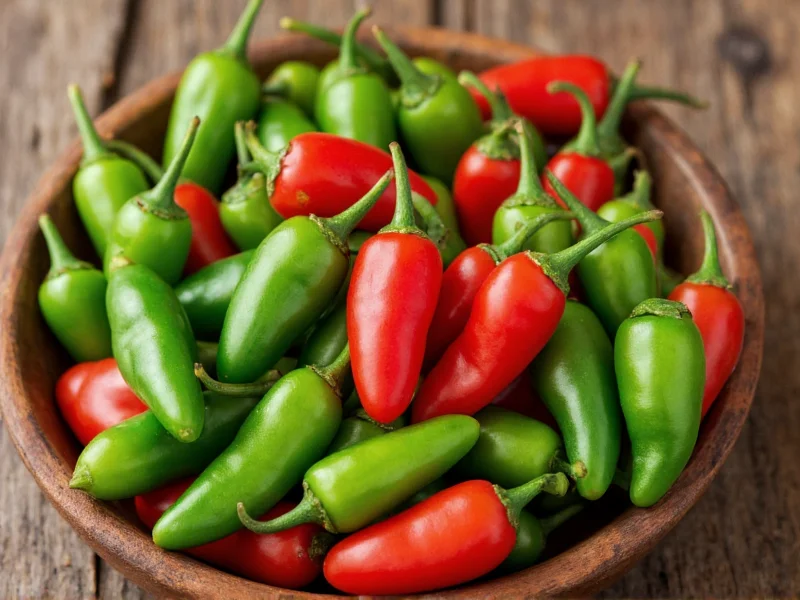When comparing serrano pepper heat level compared to jalapeno, the difference is substantial and scientifically measurable. Understanding this heat disparity helps home cooks and culinary professionals make informed decisions when selecting peppers for recipes. Let's examine the specifics behind this common kitchen question: are serranos or jalapenos hotter.
Understanding Pepper Heat Measurement
Pepper heat is measured using the Scoville scale, which quantifies the concentration of capsaicinoids—the compounds responsible for that burning sensation. Developed by Wilbur Scoville in 1912, this scale remains the standard for comparing how much hotter are serranos than jalapenos and other chili varieties.
Modern testing uses high-performance liquid chromatography (HPLC) for precise measurement, converting capsaicinoid concentration into Scoville Heat Units (SHU). This scientific approach provides objective data for comparing pepper heat levels rather than relying on subjective taste tests.
Detailed Heat Comparison: Serranos vs Jalapeños
The heat difference between these two popular Mexican peppers is significant. Here's a precise comparison of their heat ranges:
| Pepper Type | Scoville Heat Units (SHU) | Relative Heat Comparison |
|---|---|---|
| Serrano Pepper | 10,000-23,000 SHU | 2-9 times hotter than jalapeños |
| Jalapeño Pepper | 2,500-8,000 SHU | Baseline for comparison |
| Mild Jalapeño | ~2,500 SHU | Serranos can be up to 9 times hotter |
| Average Jalapeño | ~5,000 SHU | Serranos are typically 2-4.5 times hotter |
This serrano vs jalapeno scoville units comparison reveals why substituting one for the other without adjustment can dramatically alter a dish's heat profile. The minimum heat of a serrano (10,000 SHU) exceeds the maximum heat of a jalapeño (8,000 SHU), creating a complete overlap where even mild serranos surpass hot jalapeños.
Factors Influencing Pepper Heat Levels
Several variables affect the actual heat you'll experience with both pepper varieties:
- Growing conditions: Stressors like water scarcity increase capsaicin production
- Ripeness: Riper peppers (red varieties) tend to be hotter than green ones
- Plant genetics: Different cultivars have varying heat potentials
- Part of the pepper: The placenta (white ribs) contains the highest concentration of capsaicin
- Preparation method: Removing seeds and membranes reduces heat significantly
These factors explain why you might occasionally encounter a particularly hot jalapeño or a milder serrano, though the overall pattern consistently shows why are serrano peppers hotter than jalapenos on average.
Practical Culinary Implications
Understanding the heat difference between these peppers has direct consequences in the kitchen:
When recipes call for jalapeños but you want more heat, substituting serranos requires careful adjustment. A one-to-one substitution often creates an unexpectedly spicy dish. For most recipes, use approximately one serrano for every three jalapeños to maintain similar heat levels.
The question can I substitute serrano for jalapeno has a definite answer: yes, but with quantity adjustments. Serranos work well as a substitute when you remove seeds and membranes and use fewer peppers. Their thinner walls also mean they cook faster and can become mushy more quickly than jalapeños.
Visual and Flavor Differences
Beyond heat, these peppers differ in appearance and flavor profile:
- Shape and size: Serranos are smaller (1-3 inches), straighter, and more tapered than jalapeños (2-4 inches), which are thicker and often slightly curved
- Color progression: Both start green and ripen through red, orange, or yellow, but serranos maintain crispness longer
- Flavor profile: Serranos have a brighter, more floral heat, while jalapeños offer a more earthy, grassy flavor with moderate heat
- Wall thickness: Jalapeños have thicker walls, making them better for stuffing, while serranos' thinner walls suit salsas and sauces
When to Choose Each Pepper
Understanding cooking with serrano peppers instead of jalapenos helps determine which pepper serves your culinary purpose best:
Choose jalapeños when you want:
- Milder heat that won't overpower other flavors
- Peppers for stuffing (like jalapeño poppers)
- A more versatile pepper for pickling or roasting
- A gradual heat that builds slowly rather than immediate intensity
Choose serranos when you want:
- More pronounced heat without switching to extremely hot peppers
- Crisp texture for fresh salsas and pico de gallo
- Brighter, more complex flavor in sauces and marinades
- A pepper that maintains heat integrity when cooked
Managing Heat in Recipes
Whether using serranos or jalapeños, you can control heat levels through several techniques:
- Remove seeds and white membranes (placenta) where most capsaicin concentrates
- Soak cut peppers in salt water or vinegar to reduce heat
- Add dairy products like yogurt or sour cream to counteract heat in finished dishes
- Balance heat with sweet elements like honey or fruit
- Start with less pepper than recipe suggests, then adjust to taste
Remember that cooking concentrates heat initially, but prolonged cooking can eventually break down capsaicinoids. This jalapeno pepper heat range knowledge helps you adjust cooking times based on your desired heat level.
Pepper Handling Safety
When working with hotter peppers like serranos, proper handling prevents discomfort:
- Wear gloves when handling, especially when cutting multiple peppers
- Avoid touching your face, particularly eyes, while handling peppers
- Wash hands thoroughly with soap and water after handling
- Clean cutting boards and knives immediately after use
- If you get pepper juice in your eyes, rinse with milk or a dairy product rather than water
Serranos' higher capsaicin content means they require more careful handling than jalapeños, especially for those with sensitive skin.











 浙公网安备
33010002000092号
浙公网安备
33010002000092号 浙B2-20120091-4
浙B2-20120091-4